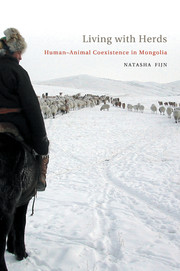Book contents
- Frontmatter
- Contents
- Lists of Plates, Figures, Maps, Tables, and Online Video Segments
- Glossary
- Acknowledgments
- LIVING WITH HERDS
- PART ONE CROSSING BOUNDARIES
- PART TWO THE SOCIAL HERD
- PART THREE LIVING WITH HERDS
- 7 IN THE LAND OF THE HORSE
- 8 THE CYCLE OF LIFE: BIRTH TO DEATH, SPRING TO WINTER
- 9 THE DOMESTIC AND THE WILD
- 10 THE SACRED ANIMAL
- CONCLUSION: CO-DOMESTIC LIVES
- Appendix
- References
- Index
- Plate section
9 - THE DOMESTIC AND THE WILD
from PART THREE - LIVING WITH HERDS
Published online by Cambridge University Press: 03 May 2011
- Frontmatter
- Contents
- Lists of Plates, Figures, Maps, Tables, and Online Video Segments
- Glossary
- Acknowledgments
- LIVING WITH HERDS
- PART ONE CROSSING BOUNDARIES
- PART TWO THE SOCIAL HERD
- PART THREE LIVING WITH HERDS
- 7 IN THE LAND OF THE HORSE
- 8 THE CYCLE OF LIFE: BIRTH TO DEATH, SPRING TO WINTER
- 9 THE DOMESTIC AND THE WILD
- 10 THE SACRED ANIMAL
- CONCLUSION: CO-DOMESTIC LIVES
- Appendix
- References
- Index
- Plate section
Summary
Biology is relentlessly historical, all the way down. There is no border where evolution ends and history begins, where genes stop and environment takes up, where culture and nature submits, or vice versa. Instead, there are turtles upon turtles of naturecultures all the way down.
(Haraway 2004: 2)INTRODUCTION
To Mongolian herders, “wild animals” are those that do not enter the domestic sphere of the encampment. Herd animals are seen as part of the extended family. According to Naraa, a wild animal is afraid of humans and hides on the forested slopes, or high in the mountains where few herders would venture on horseback. A co-domestic animal is “fed by people” and nurtured as part of the co-domestic sphere (geriin tejeever). When I asked Naraa what she thought “to domesticate'” meant, she answered with a succinct, practical reply: “we feed them and they feed us.” In fact, Mongolian herders provide only minimal supplementary feed to the herds; however, I interpret her answer to mean more broadly that a herder's role is to nurture, and that then the animals will in turn provide for the herder.
In the previous chapters I focused on herd animals and their closely intertwined lives with herders within the co-domestic sphere of the encampment. This chapter goes beyond this co-domestic realm to encounter other animals and plants that live outside this sphere, inhabiting the forest and mountain slopes and those beings that do not have regular contact with humans.
- Type
- Chapter
- Information
- Living with HerdsHuman-Animal Coexistence in Mongolia, pp. 201 - 220Publisher: Cambridge University PressPrint publication year: 2011



